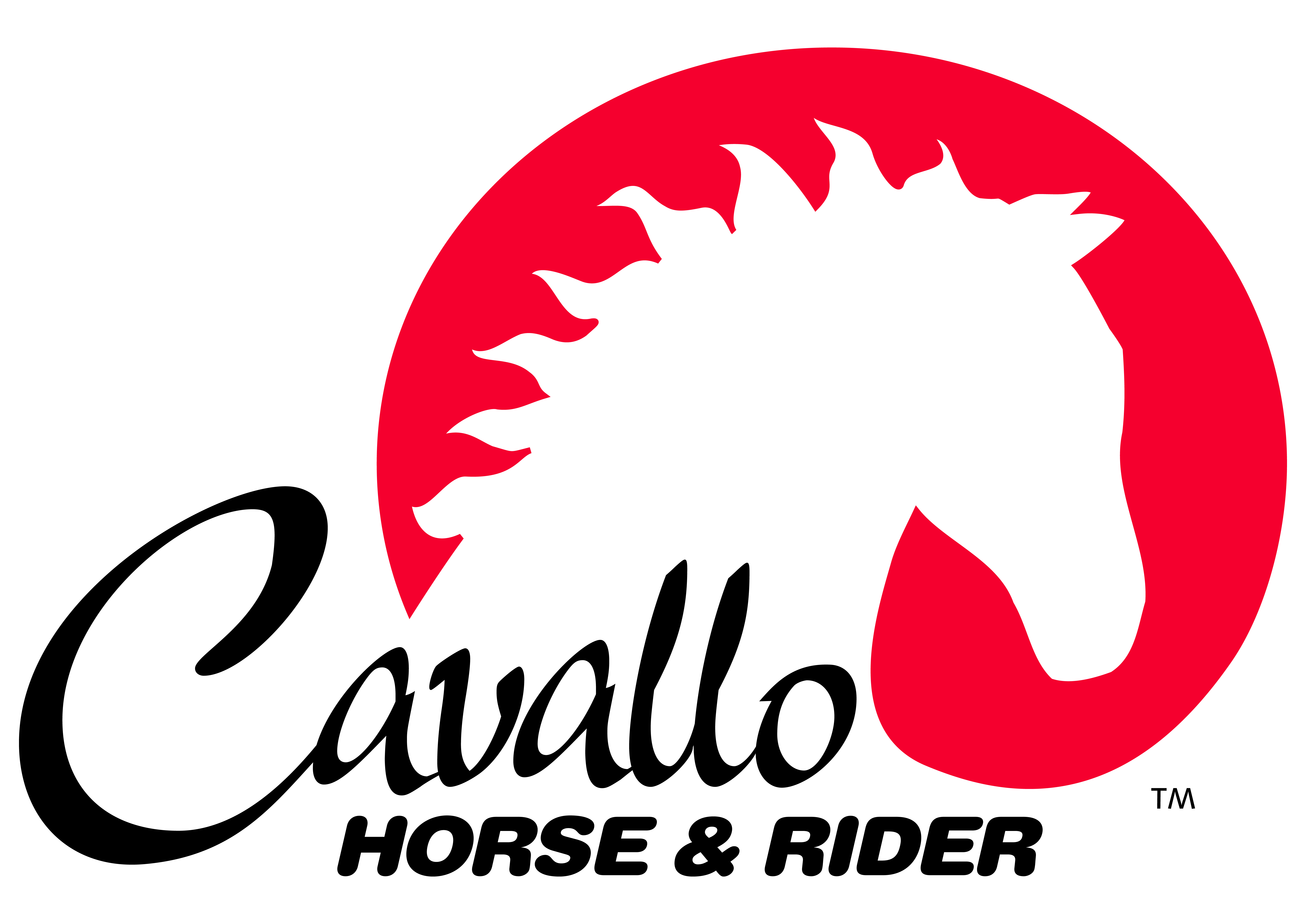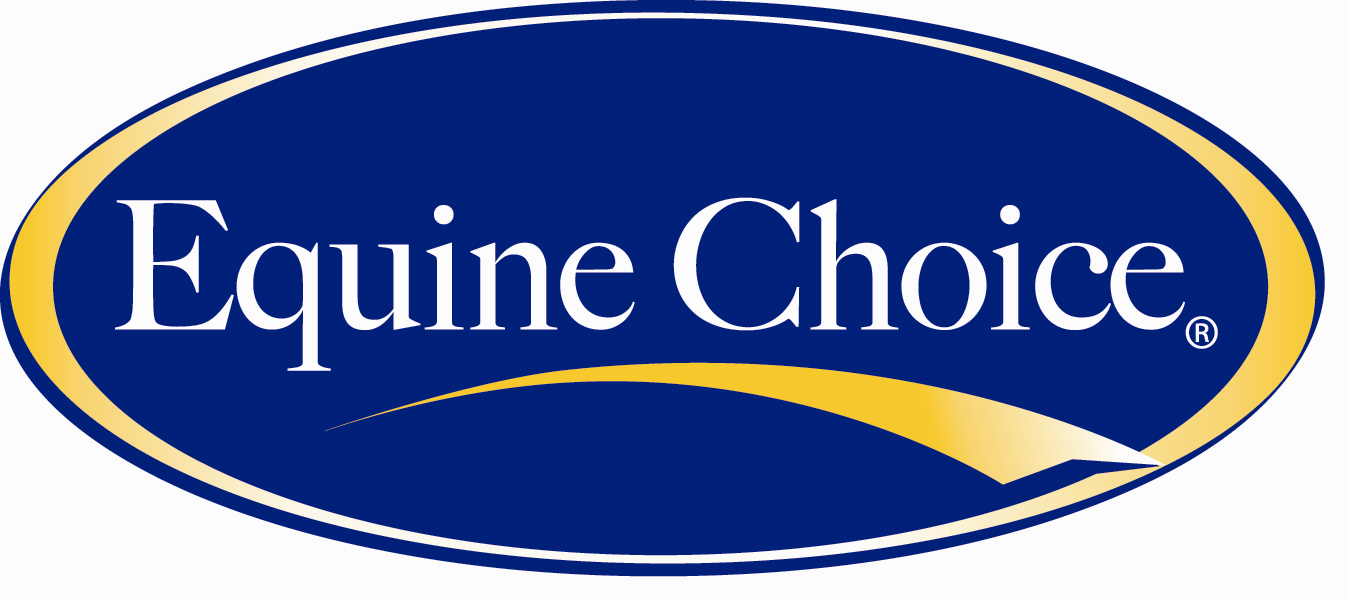
5 Easy Ways to Build Trust with Your Horse
By Lindsey Partridge (formerly Forkun)
Trust is absolutely crucial when working with horses. You need to trust your horse, and your horse needs to trust you.
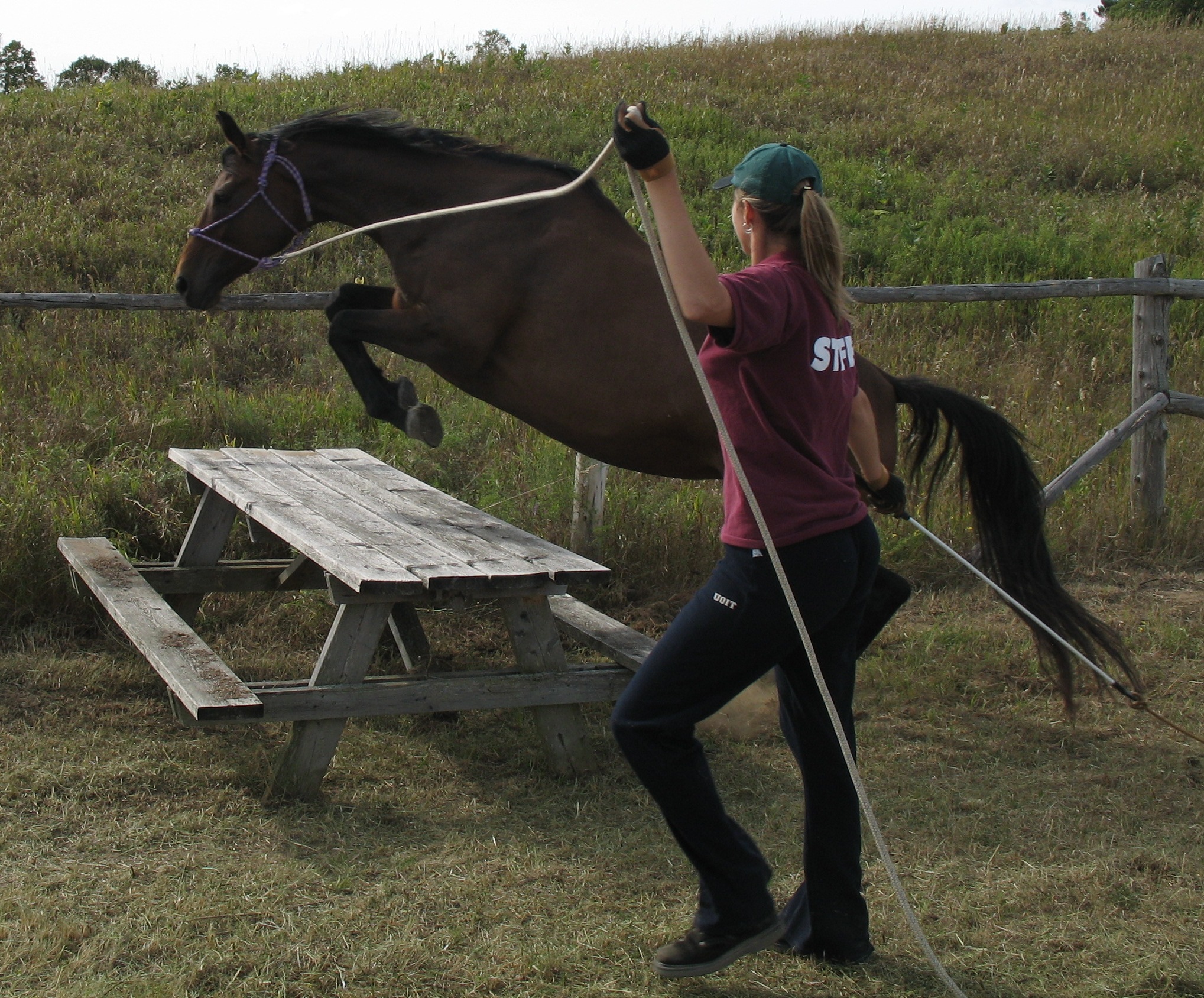 Your horse needs to know that you will keep them safe and only ask them to do things that they are capable of. You need to trust that your horse can act like a partner and be responsible.
Your horse needs to know that you will keep them safe and only ask them to do things that they are capable of. You need to trust that your horse can act like a partner and be responsible.
If your horse doesn’t trust you then you will end up with refusals, skittish behaviour, and unpleasant experiences. If you don’t trust your horse then your horse won’t learn to be responsible, he won’t like you because you are too controlling and predator like, and you won’t develop a relationship where your horse wants to work for you.
You can only get the best out of your horse when you can both trust each other.
Here are some easy ways you can begin to build trust.
Protect Your Space:
The most important step in building trust with your horse is to protect your personal space. I often see humans wanting to snuggle up with their horses, except the horse ends up rubbing too hard and causing the human to step backward – or when its time for the snuggle session to stop the human backs away instead of the horse.
A horse is supposed to see you as a strong and great leader that can keep both yourself and the horse safe – but if you can’t even protect your own space, then how on earth are you going to protect your horse from the scary wolf that hides in the arena, or the alligator that is waiting to jump out from behind the rock on a trail?
People often don’t fully understand the massive impact that protecting your personal space can have. In general, you need to be more aware of your feet….. DON’T move your feet! If you are done with your snuggle session, you back the horse away – but you DON’T move your feet.
If the horse is standing with you while you are waiting for something, grooming, etc and he gets too close for comfort, you move your horse – but you DON’T move your feet.
The second part to this is making sure that you don’t move your feet when you go to back the horse up either. Instead wiggle your rope, flap your arms (do the chicken dance!), etc to get your horse to back up out of your space – but you DON’T move your feet.
You only move your feet when you decide its time to move on or to ask for something different. You should only let your horse into your personal space if you relax your position (turn your belly button away from your horse) and invite your horse in.
If you stand facing your horse, your body language suggests you are standing your ground and the horse should not come into your space. Only if you relax your posture and invite the horse in, should the horse come to greet you.
 Protect Your Horse:
Protect Your Horse:
While protecting yourself and your space, you need to protect your horse. This means protecting your horse from any human, animal, or objects that could hurt him.
This responsibility starts as soon as you enter the paddock – you need to make sure that no other horse touches your horse. Even if the other horse is trying to touch your horse gently, you should not allow it.
You are the leader of your horse, and your horse needs to see you as the leader. Sometimes I hear stories of horses protecting their humans from other horses or scary objects – although it is nice the horse cares for you, it shows that the horse thinks that you need protecting, when instead if you are the leader you should be protecting your horse - not the other way around.
If you let your horse take on the leadership role by letting your horse be the one to get the other horses away or shield you from a scary object, then you are sending a dangerous message to your horse – you are telling your horse that you are the follower and not the leader - which means the horse makes the decisions not you.
This can be dangerous because then it becomes confusing who makes decisions… so when you are riding or playing the horse might have his own ideas about what to do and how to do it – and this can be dangerous…. especially if you are cantering along and the horse decides to quickly change direction, refuse to jump, or to take off and gallop all because the horse thinks he can make his own decisions and doesn’t recognize you as a leader.
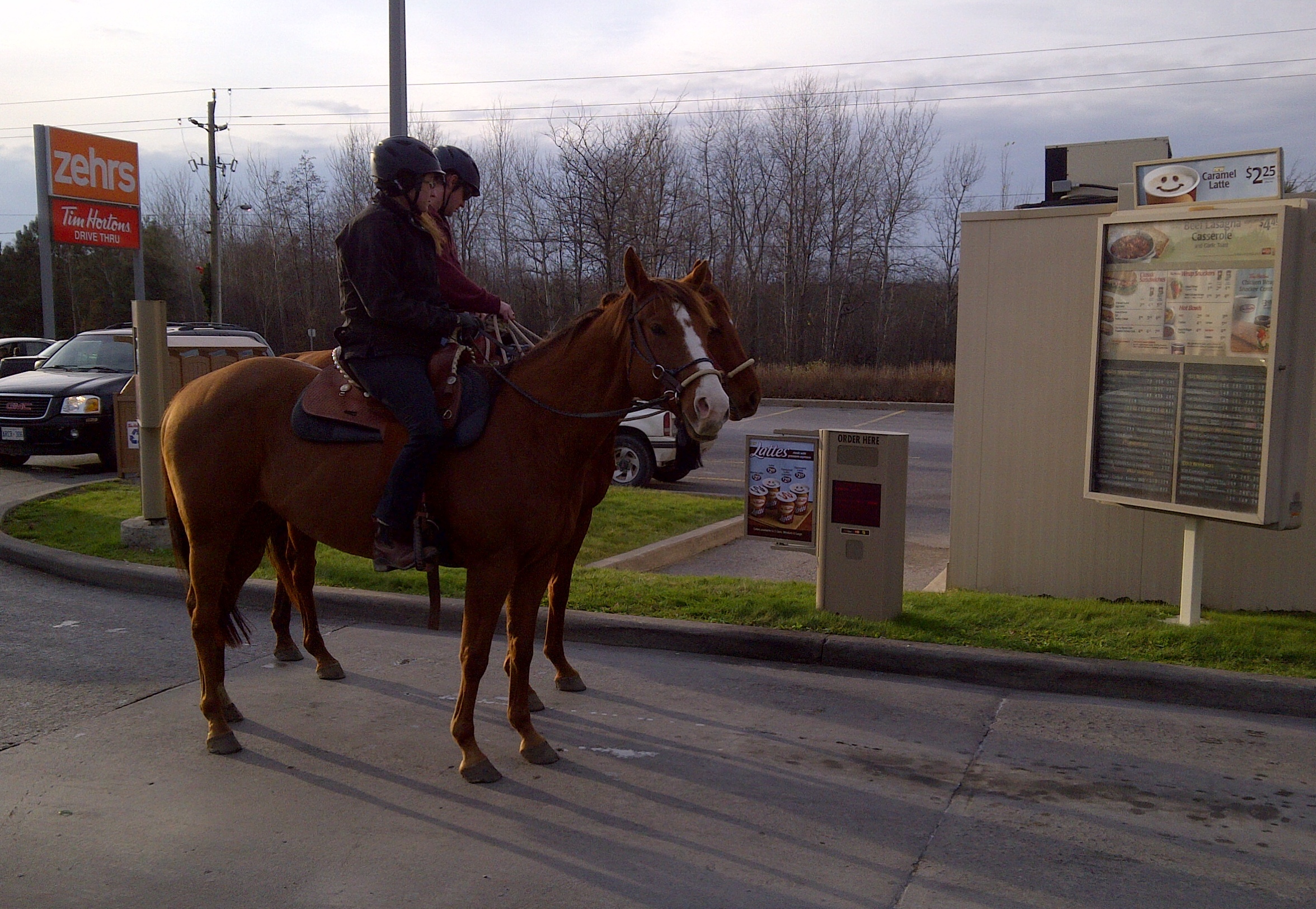 Provide a Focus:
Provide a Focus:
As a protective and great leader, it is also your job to provide a focus to your partnership. Everything you do should be because you provided that focus or goal. Your focus can be as simple as ‘lets graze,’ 'lets wait in the Tim Hortons drive thru,' (pictured right) or more complex like ‘lets perform alternating flying lead changes.’
No matter what you choose for your focus, you need to know what you are doing, and your horse needs to know what is expected of him.
For example, if you are standing in the barn grooming you can provide the focus that the horse is to stand still. If the horse starts to move around then you continue to provide the same focus by correcting your horse back into the same spot for grooming – and then trust your horse again to stand still (don’t stay tight on the lead rope).
Another example, if you are riding and you want the horse to follow a circle pattern. You can start riding the circle pattern and try to ride using your body, if your horse isn’t following the circle pattern then correct with the rein until the horse is back on the circle and then allow the horse to follow the circle pattern without micromanaging with the reins.
You provide the focus, trust your horse to follow your focus, and you correct your horse politely if you need to. You are patiently persistent at correcting your horse until they understand and follow your focus.
Remember to keep your focus reasonable – if your horse doesn’t usually come in to be handled it might be unfair to ask the horse to stand for an hour while you pull their mane. Instead ask for 10 minutes of standing, then have a break, and then ask for 15 minutes and then have a break, etc. Or if your horse is only just learning flying lead changes then just ask for one lead change and then a walking reward break.
You can also have a focus that allows your horse to offer ideas. For example you may be riding a pokey horse and your focus is to get the trot moving forward, but if your horse gets confused and offers canter, you could accept the canter for a few strides (because the horse still responded positively by moving forward) and then correct the horse by breaking to trot – that way the horse won’t feel afraid of offering ideas to you – because you will stay polite and recognize when your horse is trying, but just misunderstood you.
A common example of how horse’s change their rider’s focus: A rider may start to ask a horse to turn, but the horse resists and pulls against the rider, so instead of insisting the horse turn in the direction the leader first suggested, the leader lets the horse change their focus and instead switches reins and starts asking the horse to go the other way.
Be careful! Have a focus, communicate your focus to your horse, and don’t allow your horse to change your focus.
Being able to provide a focus to your horse, and being able to stick with a focus will help build trust in your horse. This is because your horse will believe you when you try to tell your horse that something isn’t scary… because you don’t change your mind, the horse knows that in 5 minutes you will still be saying the object isn’t scary.
If you allow your horse to change your focus, your horse learns that you change your mind and you aren’t really sure about what to do, what not to do, etc, so when you approach something scary and try to tell the horse it isn’t scary, the horse may not believe you.
Encounter Wait, Revisit
Some horses are naturally braver than other, and some horses tend to be fairly skittish and flighty. Horses can become more confident when they are exposed to many different things – when they associate positive experiences with the different objects/ environments.
Getting your horse to touch different objects is one way to build confidence. Provided the horse doesn’t get hurt or intimidated during the experience.
When introducing new things to your horse, remember the Natural Horsemanship Principle ‘Encounter, Wait, Reviist’ (to learn all 7 natural horsemanship principles, I recommend ‘Natural Horsemanship: Answering the What, Why, and How for All Disciplines).
- You encounter a new/scary something.
- As soon as your horse shows the slightest sign of worry or anxiety you stop and wait.
- You wait at the exact spot that your horse first started to get anxious.
- You wait until your horse asks a question or shows signs of being more comfortable.
- Once your horse has asks a question or is more comfortable, you back away/move away to reward the horse.
- Start over by revisiting the new/scary something again.
It is important that while you are waiting, that you keep your horse facing the scary object/ or keep the object touching the horse in the same place as when the anxiety first started. This way the horse doesn’t learn to run or escape from what is scary. You simply wait in the exact spot that you first noticed the anxiety.
For example, if you start to approach a scary tarp and your horse’s head goes high and alert. You would stop in your tracks with the horse (or your horse may have stopped all by himself) and wait for the horse to lower his head more relaxed and/or flick an ear toward you to ask a question. You answer that question by backing up a few steps, allowing a pause for reward, and then asking the horse to move forward again (you are only asking the horse to take steps forward that he was already okay with).
Another example would be if you are touching your horse with something new, like clippers, and you get to a spot where your horse starts to be uncomfortable, lets say his tummy. You would hold the clippers on the exact spot near his tummy/on his tummy where you first saw signs of anxiety (the horse starts to swish his tail, raise his head, prance about, etc). When the horse is relaxed (stopped swishing his tail, lowered his head, stands still, etc) you immediately take the clippers away. Then you start over by clipping an area the horse is comfortable and slowly approach the tummy area again.
By following this approach you teach your horse that there is no need for explosive behaviour like bolting, biting, striking out, or kicking, because you respond to the slightest cue from the horse like tail swishing, prancing, or head raising. You also teach your horse that if the horse stands still/relaxes that the horse will be rewarded, not taken advantage of.
Think about it. If your horse is really anxious about mounting, tossing the saddle pad on, clipping, etc – the horse shows you this by prancing a little, or raising his head in a worried manner – but then the horse decides to offer to stand still…. So then if you react by quickly getting on, tossing the saddle pad on, or sneaking in a quick clip – then you punish your horse for standing still… you do exactly what the horse was anxious about. Instead if you reward the horse by backing away (starting over) then the horse can feel comfortable that you won’t advance until the horse is ready.
What’s more, is your horse will trust you more as a leader because you demonstrate that you understand the horse. You also teach the horse that you have patience and that you will eventually get on the horse, put the saddle pad on, clip, etc but that you are willing to make sure the horse is comfortable.
This means you are a partner, not a dictator to be feared.
Test your relationship and explore new objects: introduce tarps, balls, clippers, massagers, plastic bags, tossing lead ropes over the horse, go over poles, cross bridges, stand in water, stand on a pedestal, use stuffed toys, hula hoops, and whatever you can think of! Keep it safe, keep it interesting.
You can also change up the scenery in your arena/play area by posting signs, hanging drapes/curtains in different areas, moving different things around like barrels, jumps, etc. Your horse should be comfortable in a changing environment so try NOT to always store your jumps in the same corner, or always park the gator in the same spot, or always have the mounting block in the same corner, etc.
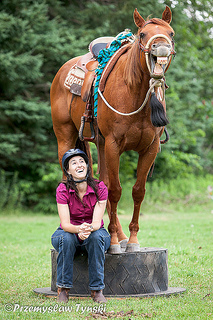 Interactive Play
Interactive Play
Once you have introduced your horse to a variety of things, it is important to try and give the objects a purpose or make them part of your play.
This is were you get to be creative and think of ways you can incorporate your ground and riding cues into challenging games that can test your communication, build confidence, and ultimately build a better partnership.
- Instead of just walking over a pole, try having your horse halt halfway over
- Try getting your horse to put all four feet on the pedestal
- Have your horse walk sideways over a pole
- Have your horse do a haunch/forehand turn while keeping their hind/front feet in a hula hoop
- Send your horse over various jumps from the ground (either free jumping or online)
- Get your horse to put one foot on a tire
- Back your horse through a set of pylons or flower boxes
- Do a figure 8 pattern around barrels, flowers, or buckets (use different objects as markers)
- Have your horse walk in-between to benches, poles, or jumps – see how narrow a space your horse will walk through (great for trailer loading practice)
- Walk over a tarp or shower curtain
- Trailer load – can you load your horse halfway into a trailer? What about all the way? What about backwards?





